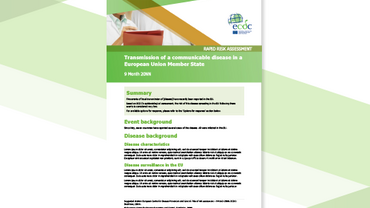Risk assessment: Seasonal influenza 2014–2015 in the EU/EEA countries
This risk assessment covers the 2014–2015 influenza season in the European Union and European Economic Area (EU/EEA).
Executive Summary
Medium or high rates of influenza intensity are likely to be observed in the vast majority of EU and EEA countries, concludes ECDC annual risk assessment on influenza for the remainder of the season. The number of severe cases of influenza as well as fatal outcomes especially among older people and other risk groups can be expected to rise.
Strenuous start of this influenza season
- Influenza activity in Europe started in week 50/2014 without a particular geographic progression, affecting the Netherlands, Sweden and England first, and then followed by Iceland, Malta and Portugal.
- Children between 0 and four years of age have been the most affected age group according to primary healthcare data in almost all reporting countries, similarly as in other seasons.
- Influenza-like illness and acute respiratory infections have been increasing in adults and older people in almost all countries.
- Most of the first affected countries report greater pressure on primary healthcare services during this season compared to the peak activity in previous season.
- Among the countries reporting hospitalised influenza cases, 34 fatal outcomes were reported, two thirds of these in the elderly.
Drifted A(H3N2) viruses dominant
- Subtype A(H3N2) viruses, known to cause more severe disease, are dominant in almost all reporting European countries.
- Majority of A(H3N2) viruses analysed are antigenically distinct from the A(H3N2) virus included in the vaccine for this season.
- Reduced vaccine effectiveness is expected as a result of this mismatch between the vaccine and the circulating influenza strains.
ECDC Director, Dr Marc Sprenger, said:“We face an influenza season that could be more severe and exert bigger pressure on health care systems than in the last few years. As each year, ECDC undertakes a risk assessment early in the season, combining a multitude of data sources and aiming to inform and strengthen EU and EEA countries in their response to the influenza epidemics.”
How to protect oneself and others from the flu
- Self-isolation when sick, hand-washing and good respiratory hygiene as well as cough etiquette remain simple yet effective measures to protect from catching or passing on influenza.
- A lower overall vaccine effectiveness due to the circulation of drifted A(H3N2) viruses is expected, however, the vaccine may still reduce complications and severe outcomes associated with this subtype of influenza viruses.
- Influenza vaccine offers good protection against the circulating A(H1N1)pdm09 viruses.
Antivirals particularly important this season
Treatment and post-exposure prophylaxis with antivirals protects the elderly and people in other risk groups against severe influenza illness.
The circulating viruses are susceptible to antiviral drugs oseltamivir and zanamivir.
Dr Marc Sprenger emphasizes:“In a season dominated by a drifted A(H3N2) strain of influenza viruses, more severe illness can be expected especially among older people and those in medical risk groups. It is therefore paramount that physicians across Europe consider treatment and post-exposure prophylaxis with antivirals especially for these patients.”
The annual ECDC risk assessment of seasonal influenza aims to provide an early description of seasonal influenza in the first affected countries and to inform public health decisions to be taken to reduce the burden of seasonal influenza in 2015 in Europe.







